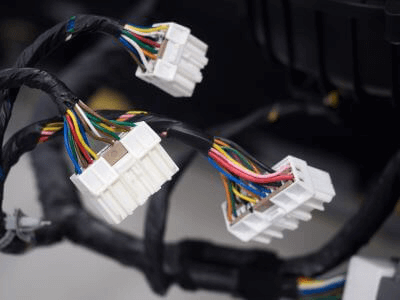What Is a Connector Terminal?
 A connector terminal is a component that connects electronic circuit boards, electronic components, and electronic wiring in a way that allows easy connection and disconnection.
A connector terminal is a component that connects electronic circuit boards, electronic components, and electronic wiring in a way that allows easy connection and disconnection.
There are male and female connectors, and when they are connected, they are energized. Since there are pairs of male and female connectors, each with its specialized combination, connecting the wrong one can cause poor contact. Insert contacts with wires crimped to the connector terminal and secure them in place.
Installation and removal of connector terminal depend on the lock shape at the time of connector mating and varies depending on the application, from those that can be easily detached to those that cannot be easily removed.
Uses of Connector Terminals
Connector terminals are used in many situations for communication and power supply between devices because they can be detached and can protect and insulate contacts.
The use of connector terminals improves the maintainability and convenience of equipment and the reliability of connection points. They are used in devices with electronic circuit boards and electronic components and have a wide range of applications.
1. Automobiles
Connections for electronic components and electronic wiring, connections between electronic circuit boards and electronic boards used in ECUs, etc. High-current connections for electric vehicles, and high-speed transmission connections for sensors such as cameras for automatic driving.
2. Smartphones
Connector terminals are used for connections between electronic circuit boards, USB connections, etc.
3. Industrial Equipment
Connector terminals are used for highly reliable power supply connections, high-current connections for solar panels, high-speed transmission connections for communications, etc.
Principle of Connector Terminals
Connector terminals are provided in pairs, male and female, and can be easily connected and disconnected electrically by removing and installing the connector terminals.
Connector terminals are mainly used for:
- Contacts to energize
- An insulator to hold the contact
- A shell to protect the insulator
The above three components make up a connector terminal.
1. Contact
Contacts are metal conductor parts that conduct current and transmit electrical signals. As with connector terminals, there is a pair of male and female contacts, and connecting the wrong one can cause poor contact.
Although contacts can conduct electricity, even if they are touching each other, depending on the grounding area, etc., electrical resistance may increase and transmission loss may increase, resulting in low reliability. For this reason, the mating surfaces of male and female contacts are designed to have moderate mating dimensions that can be removed and attached using the springiness of the metal, and a certain contact pressure is applied.
2. Insulator
Insulators are mainly composed of insulating resin and have the functions of holding contacts in a certain position and insulating and protecting contacts from the outside. There is a wide range of insulators, from those that can hold numerous contacts, to those with levers that cannot be easily removed, to those with rubber or other material on the mating surface of the male and female contacts to provide waterproof performance.
3. Shell
Shells are metal parts that generally protect insulators, and are mainly used when they are fixed to the sides or back of equipment or when electrical noise suppression is required. There are a wide variety of shells, including metal, plastic, and waterproof ones, and they should be selected according to the application.
Other Information on Connector Terminals
Types of Connector Terminals
There are four major types of connector terminals based on the connection method.
- Connection of electronic circuit boards to electronic wiring: Board to Wire (B to W)
- Connection of electronic circuit board to electronic circuit board: Board to Board (B to B)
- Connection of electronic devices to electronic devices: INPUT / OUTPUT (I / O)
- Connection of electronic circuit boards to electronic components: short-circuit connectors, IC sockets, etc.
1. Connection of Electronic Circuit Boards and Electronic Wiring
Connect electronic circuit boards and wires via connector terminals. Since wires can be freely routed according to their length, they are most commonly used for their ease of use.
2. Connection of Electronic Circuit Boards to Electronic Circuit Boards
Electronic circuit boards are directly connected with connector terminals. Since no wires are involved, electrical resistance is low and signal transmission efficiency is high.
3. Connection of Electronic Devices to Electronic Devices
Electronic devices are connected to electronic devices via connector terminals and wires. This is mainly used to exchange signals between devices.
4. Connection Between Electronic Circuit Boards and Electronic Components
Connections are used on electronic circuit boards, where connector terminals are used as sockets for shorting circuits or plugging in ICs or relays.